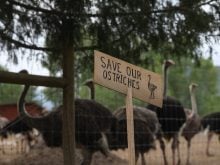GLEN VALLEY, B.C. – As Chris Ormel prepares another udder for milking, his thoughts travel across the road to the Fraser River and he talks of two other big flood years in the Glen Valley, 1997 and 1948.
Ormel’s 80-head dairy farm lies on a gentle bend in the Fraser River valley, between the river and a dike formed by the CN Rail main line, near Abbotsford, B.C.
In a year when the river is expected to crest near or above its banks that location can be a concern for Ormel and some of his 300 neighbors.
Read Also

VIDEO: Agritechnica Day 4: Robots and more robots, Nexat loves Canada and the trouble with tariffs
Agritechnica Day 4: Robots and more robots, Nexat loves Canada and the trouble with tariffs.
“We’re OK here,” he said. “In (1948) this farm was high ground, they say. You couldn’t leave. All the roads were under water. That even happened two years ago, but we could still travel then.”
Many of Ormel’s neighbors may not be so lucky as they live and farm inside the rail bed or on lower parts of the valley where there is no protection. The river valley is home to tens of thousands of chickens, thousands of pigs and dairy cattle on nearly every farm.
Emergency Measures officials have warned residents that they may need to move valuables, livestock, feed and farm equipment to higher ground if this spring’s melt picks up speed too quickly.
In 1997 some Glen Valley farmers found themselves moving cattle onto the CN Rail mainline railway bed because of its fenced high ground. That year many of those farmers lost crops already sowed to corn and barley.
While none of the provincial or municipal officials are calling 1999 a serious flooding year yet, they say the chance of catastrophic flooding this year is about 10 percent. Snowpacks are now more than 45 percent higher than normal in the Fraser River basin from Prince George to Lillooet. In the lower Fraser from Kamloops to Vancouver that jumps to 65 percent.
If weather turns cool at higher elevations and snow remains until mid- to late-May, or if heavy rain falls on the Pacific coast during the May melt, the movement of water through the Fraser Valley could accelerate.
The British Columbia River Forecast Centre reports that cool conditions have been the norm so far this spring, but recent above average temperatures have created some optimism for a more gradual melt.
In 1997 farmers and rural residents from lower mainland areas all felt the effects of the heavy snow pack melting too quickly.
Neil Banera, manager of public safety for the ministry of environment, said the snow cap in the mountains is higher than in 1997, a year in which year the B.C. government spent more than $75 million fighting floods.
The environment department is releasing about $4 million this week for flood preparedness programs. That money will help to fund 49 separate community projects, most of which involve dike repair or improvements. Environment officials say snowpacks in 1972 were similar to 1999 levels and that year provided high runoff with little flooding.
“We’re farmers down here. We know that what will come will come. If need be, we’ll get our cattle out of here, but for now we’ll just keep on dairying as normal,” said Ormel.
The web addresses for more info are: www.env.gov.ca/at/snow_bulletin and www.env.gov.bc.ca.














